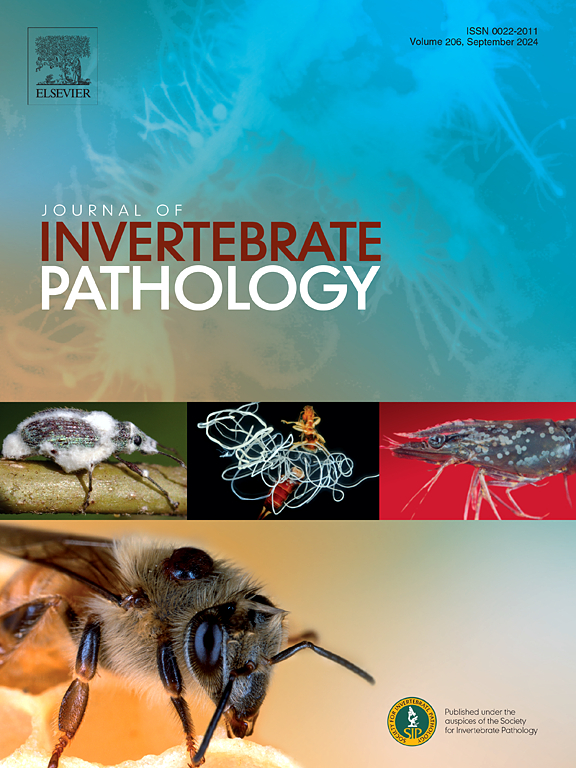丛枝菌根真菌会影响专性根饲养者与其天敌之间的地下相互作用。
IF 3.6
3区 生物学
Q1 ZOOLOGY
引用次数: 0
摘要
作为初级生产者,植物在调解各营养级之间的相互作用方面发挥着核心作用。虽然植物是食草昆虫的主要食物来源,但它们也能保护自己免受食草昆虫的伤害。许多植物会产生有毒化合物,直接减少食草昆虫的食量,但植物也会通过挥发性信号吸引攻击食草昆虫的天敌,从而间接保护自己。这些所谓的 "三营养交互作用 "历来被记录在植物气生部分的地上部分,但也已知发生在根系的地下部分。除食草动物外,植物还与其他生物直接相互作用,从而影响三营养体相互作用的结果。丛枝菌根真菌(AMF)是一种共生土壤微生物,可定植于植物根部并促进养分吸收。这些微生物可以改变植物的化学性质,进而提高对食草动物的抵抗力。然而,很少有研究显示 AMF 如何影响地上或地下的三营养交互作用。本研究探讨了当植物受到西部玉米根虫(玉米的一种问题害虫)的攻击时,AMF 的定殖如何影响根部挥发性物质的释放,以及随后如何吸引西部玉米根虫的天敌--昆虫病原线虫。菌根真菌提高了根虫的存活率,但降低了幼虫的体重。根部挥发性物质之间存在差异,但挥发性信号与线虫行为之间没有明确的联系。线虫更容易被土壤中没有根虫的非菌根植物和单独的 AMF 所吸引,这表明 AMF 可能会干扰线虫用来定位猎物的与挥发性物质结合使用的线索。本文章由计算机程序翻译,如有差异,请以英文原文为准。

Arbuscular mycorrhizal fungi influence belowground interactions between a specialist root-feeder and its natural enemy
As primary producers, plants play a central role in mediating interactions across trophic levels. Although plants are the primary food source for herbivorous insects, they can protect themselves from herbivore damage. Many plants produce toxic compounds that directly reduce herbivore feeding, but plants also protect themselves indirectly by attracting natural enemies of the attacking herbivore through volatile signaling. These so-called tri-trophic interactions have historically been documented aboveground in aerial plant parts but are also known to occur belowground in root systems. In addition to herbivores, plants directly interact with other organisms, which can influence the outcomes of tri-trophic interactions. Arbuscular mycorrhizal fungi (AMF) are symbiotic soil microbes that colonize the roots of plants and facilitate nutrient uptake. These microbes can alter plant chemistry and subsequent resistance to herbivores. Few studies, however, have shown how AMF affect tri-trophic interactions above- or belowground. This study examines how AMF colonization affects the emission of root volatiles when plants are under attack by western corn rootworm, a problematic pest of corn, and subsequent attraction of entomopathogenic nematodes, a natural enemy of western corn rootworm. Mycorrhizal fungi increased rootworm survival but decreased larval weight. Differences were detected across root volatile profiles, but there was not a clear link between volatile signaling and nematode behavior. Nematodes were more attracted to non-mycorrhizal plants without rootworms and AMF alone in soil, suggesting that AMF may interfere with cues that are used in combination with volatiles which nematodes use to locate prey.
求助全文
通过发布文献求助,成功后即可免费获取论文全文。
去求助
来源期刊
CiteScore
6.10
自引率
5.90%
发文量
94
审稿时长
1 months
期刊介绍:
The Journal of Invertebrate Pathology presents original research articles and notes on the induction and pathogenesis of diseases of invertebrates, including the suppression of diseases in beneficial species, and the use of diseases in controlling undesirable species. In addition, the journal publishes the results of physiological, morphological, genetic, immunological and ecological studies as related to the etiologic agents of diseases of invertebrates.
The Journal of Invertebrate Pathology is the adopted journal of the Society for Invertebrate Pathology, and is available to SIP members at a special reduced price.

 求助内容:
求助内容: 应助结果提醒方式:
应助结果提醒方式:


